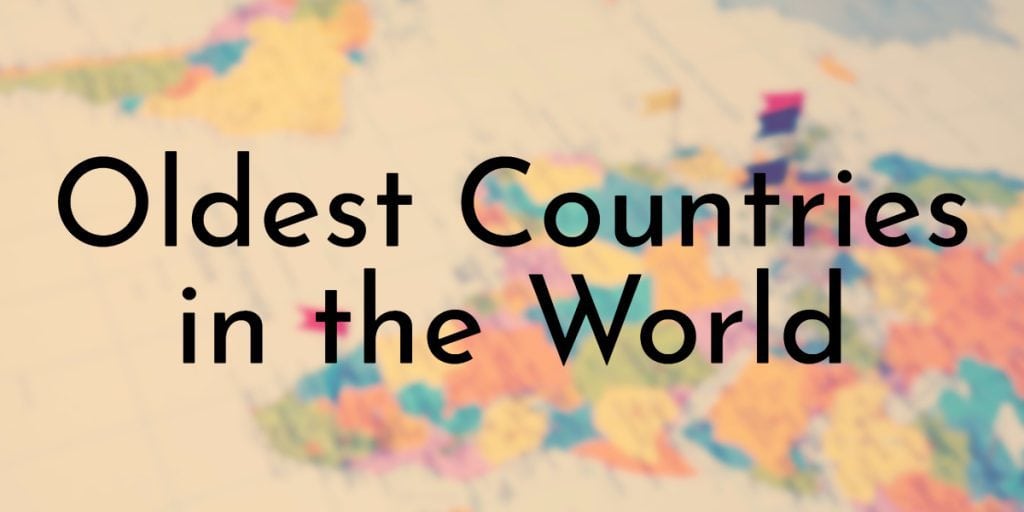Although human life began to form millions of years ago, the earliest signs of human civilizations appeared fairly recently in the human timeline. Some of the earliest civilizations developed around 6500 BCE, when people stopped living nomadic lives and began to settle in and develop one area. These early settlements soon gave rise to massive cities and the idea of separate countries and nations followed. Some of the earliest countries formed not long after civilization developed and all of the countries on this list were formed thousands of years ago.
10. San Marino
Year Founded: 301 CE
Founder(s): Saint Marinus
Capital City: City of San Marino
Current Population: 33,344 (2018 estimate)
 photo source: Wikimedia Commons
photo source: Wikimedia Commons
San Marino is one of the smallest countries in the world and is part of the Italian Peninsula. The country is very prosperous and its economy mainly relies on finance, tourism, services, and industry. San Marino has one of the Europe’s lowest unemployment rates, no national debt, and a budget surplus. Beyond its ancient origins and economic stability, San Marino also boasts a rich cultural heritage, reflecting centuries of history and tradition.
Did You Know?
San Marino is not only the oldest uninterrupted sovereign state, it also has the world’s oldest constitution, dating back to October 8, 1600. However not all of its laws are codified, so the U.S. Constitution is often considered the oldest.
9. Iran – Founded c.550 BCE
Year Founded: c.550 BCE
Founder(s): Cyrus II
Capital City: Tehran
Current Population: 81,672,300 (2018 estimate)
 photo source: Wikimedia Commons
photo source: Wikimedia Commons
Ancient Iran, which was known as Persia in the Western world until 1935, was founded around 550 BCE under the Achaemenid Empire. Prior to the rise of the Persian Empire, several groups of people lived in the area that would later become Iran – this included the Elamites, who were a pre-Iranian civilization that settled in the far West and Southwest region of modern-day Iran and the Medes, who had control of most of Iran until the Persians stepped in.
Cyrus II (commonly known as Cyrus the Great) established the Persian Empire around 550 BCE after he conquered the Median, Lydian, and Babylonian empires and gained control of Iran. The Achaemenid Empire ruled Iran until Alexander the Great conquered the Persian Empire in 330 BCE. Modern-day Iran was founded in 1979 after the Iranian Revolution ended the monarchy and an Islamic Republic was established.
Did You Know?
Iran has a rich history and currently has 22 UNESCO World Heritage sites, the third most in Asia and 11th most in the world.
8. Japan
Year Founded: 660 BCE
Founder(s): Emperor Jimmu (legendary)
Capital City: Tokyo
Current Population: 126,440,000 (2018 census)
 photo source: Wikimedia Commons
photo source: Wikimedia Commons
Japan often cites 660 BCE as the date of the country’s founding as this was when the first Emperor of Japan, Emperor Jimmu ascended the throne and began Japan’s imperial dynasty. Emperor Jimmu’s is considered a mythic legendary emperor of Japan and is believed to be a descendant of the sun goddess Amaterasu – he is recorded as Japan’s first emperor in two early chronicles, Kojiki, and Nihon Shoki. The earliest emperors of Japan, following Emperor Jimmu, are presumed to also be legendary as there is not sufficient evidence that they actually existed.
While historians can’t be sure whether or not these early emperors really existed, they do know that the people began arriving in Japan from Asian mainland around 13000 BCE and the earliest recorded history of Japan occurred during the Kofun period (c.250 AD – 538 AD). Although Emperor Jimmu’s story is most likely a myth, Japan celebrates its National Foundation Day on February 11th as a tribute to Emperor Jimmu’s ascension in 660 BCE.
Did You Know?
One of the things Japan is known for is the longevity of its citizens; the country has the highest life expectancy in the world and many people live over 100 years.
7. Greece – Founded c.800 BCE
Year Founded: c.800 BCE
Founder(s): Unspecified
Capital City: Athens
Current Population: 10,768,477 (2017 estimate)
 photo source: Wikimedia Commons
photo source: Wikimedia Commons
The Archaic period of Greece is one of the country’s most prominent time periods as it laid the foundations for Greek’s Classical period, which is known for establishing the foundations of modern western civilization. This period in Greece’s history started sometime around 800 BCE after Greece began to emerge from the Dark Ages.
During the Archaic period, the Greeks made advances in art, poetry, and technology, but the most important thing to be invented during this time period was the polis, or city-state. The polis would go on to define Greek political life for hundreds of years. Also during this time period, the Greek alphabet was developed as well as the earliest institutions of democracy.
Ancient Greece was followed by Roman Greece, Byzantine Greece, and Ottoman Greece, with the modern Greece period starting in 1821 after the Greek Revolution. It shaped Western civilization, influencing areas such as governance, arts, sports, and philosophy, and continues to be felt in modern times.
Did You Know?
Athens, the capital of Greece, has been the country’s most important city since the 1st millennium BCE.
6. Ethiopia – Founded c.980 BCE
Year Founded: c.980 BCE
Founder(s): Unknown
Capital City: Addis Ababa
Current Population: 102,403,196 (2016 estimate)
 photo source: Wikimedia Commons
photo source: Wikimedia Commons
Human life has been around in Ethiopia for millions of years as skeletal fragments belonging to Australopithecus afarensis, an apelike creature that may have been the ancestor of modern humans, that were found in the area are thought to be about 3.4 million – 2.9 million years old. As life flourished in Ethiopia, complex societies began to develop and one of the first kingdoms established was Dʿmt, which lasted from c.980 BCE – c.400 BCE.
The people of this kingdom developed irrigation schemes, used plows, grew millet, and made iron tools and weapons. After the fall of Dʿmt, the Aksumite Kingdom rose to power around 100 AD and ended sometime in 940 AD. This kingdom was followed by the Zagwe Dynasty, and the Solomonic Dynasty after that – Ethiopia would continue to be ruled by a monarchy until 1974.
Did You Know?
Ethiopia is one of the only countries in Africa to never be colonized by a European power, but it was occupied by the Italians from 1936 – 1941.
5. Georgia
Year Founded: c.15th century BCE
Founder(s): Colchians
Capital City: Tbilisi
Current Population: 3,729,600 (2016 estimate)
 photo source: Wikimedia Commons
photo source: Wikimedia Commons
Following a brief Roman conquest around 66 BCE, Rome and the Iranian states fought over Georgia for more than 700 years. Georgia also fell to early Muslim conquests in the 7th century CE. The country was subsequently ruled by the Persians and Russia. After a brief period of independence from the Russian Empire, Georgia became part of the Soviet Union. Georgian finally gained its true independence in 1991.
Did You Know?
Georgia became the second country to adopt Christianity around the early 4th century CE and the Georgian Orthodox Church is one of the world’s oldest Christian churches.
4. China – Founded c.2070 BCE
Year Founded: c.2070 BCE
Founder(s): Yu the Great
Capital City: Beijing
Current Population: 1,403,500,365 (2016 estimate)
 photo source: Wikimedia Commons
photo source: Wikimedia Commons
The first Chinese dynasty was the Xia Dynasty which lasted from c.2070 BCE – 1600 BCE. There are no first hand records from the Xia Dynasty as the written history of China dates back to the Shang Dynasty (c. 1600 BCE – 1046 BCE) – however, the Xia Dynasty is mentioned in historical chronicles such as the Bamboo Annals, the Classic of History, and the Records of the Grand Historian.
Until excavations in the 1960s and 1970s uncovered sites that provided strong evidence for the existence of the Xia Dynasty, many people believed that it was more myth than fact. China’s dynastic period lasted until 1912 when the Qing Dynasty ended and republic was formed. The People’s Republic of China was founded in 1949 and continues on as modern-day China.
Did You Know?
While the people of ancient China invented many things that we still use today, the Four Great Inventions – the compass, gunpowder, papermaking, and printing – are celebrated in Chinese culture for their historical significance and as symbols of ancient China’s advanced science and technology.
3. Afghanistan
Year Founded: c.3000 BCE
Founder(s): Unknown – possibly Indus Valley Civilization
Capital City: Kabul
Current Population: 31,575,018 (2018 estimate)
 photo source: Wikimedia Commons
photo source: Wikimedia Commons
The Indus Valley Civilization is believed to have had a colony in Afghanistan as early as 3000 BCE. They established one of the world’s first cities, Mundigak, near modern-day Kandahar. Archaeologists have also found evidence of smaller Indus Valley Civilization colonies in other parts of Afghanistan.
Over time, waves of semi-nomadic people from Central Asia settled in Afghanistan and brought their culture with them. Afghanistan was conquered by Darius I of Persia and later Alexander the Great and other various empires. The country was even influenced by the British for awhile. In 1973, Afghanistan became a unitary presidential Islamic republic.
Did You Know?
While Afghanistan is an Islamic nation today, Buddhism flourished in the country during the 1st century BCE to 3rd century CE under the Kushan Empire.
2. India
Year Founded: c.3300 BCE
Founder(s): Indus Valley Civilization
Capital City: New Delhi
Current Population: 1,324,171,354 (2016 estimate)
 photo source: Wikimedia Commons
photo source: Wikimedia Commons
People have been living in the region in the Indian subcontinent since around 3300 BCE, starting with the Indus Valley Civilization. Although these early peoples formed one of the world’s earliest urban civilizations, the beginnings of India as a nation started with the Vedic Period which lasted from c.1500 BCE – c. 600 BCE. This time period is named for the texts of Vedas, which were orally composed in Vedic Sanskrit and provided details of the Vedic culture.
The Vedic Civilization laid the foundation of Hinduism (the Vedic texts are still sacred to modern Hindus) as well as several cultural aspects of the Indian subcontinent that still exist today. The first kingdoms or Janapadas started to form c.1200 BCE and lasted until the end of the Vedic period. The end of the Vedic period led to the rise of Hinduism, Jainism, and Buddhism in India and the beginning of the powerful dynasties that would rule India for the next three milennia. Modern-day India was founded in 1947 after the country gained its independence from the British Empire.
Did You Know?
India is the seventh largest country by area and the second most populous country, after China, with population over 1.32 billion.
1. Egypt
Year Founded: c.6000 BCE
Founder(s): King Narmer (aka Menes)
Capital City: Cairo
Current Population: 94,798,827 (2017 census)
 photo source: Wikimedia Commons
photo source: Wikimedia Commons
King Narmer was able to establish control over the entire navigable length of the Nile and established the capital in Memphis, a city near modern-day Cairo. This first dynasty was the first of a series of dynasties that would go on to rule over Egypt for the next three millennia until it was conquered by Alexander the Great in 332 BCE. Modern Egypt was founded in 1953 after the Egyptian Revolution of 1952.
Did You Know?
While Egypt has a large population, the majority of its citizens live along the Nile River, where the only arable land is found (about 40,000 km² (15,000 sq mi))
OTHER POSTS YOU MAY BE INTERESTED IN












What about Georgia? )))) you must know about this country .
I think iran is oldest country,i mean iran have one old Empire
Yes you are right
Aryana or the new name Afghanistan’s is one of the oldest countries in the world.
In the past
Afghanistan was a part of Persian empire
Sri Lanka history is also one of the oldest country in the world
Axum is one of the oldest cites in the world.
It was a good magazine for the people that love historical stories but it have some problems
Iran is oldest because the Persian empire is before Greece and China and Egypt.
We have some pictures and castles that is very old and it is for world empire